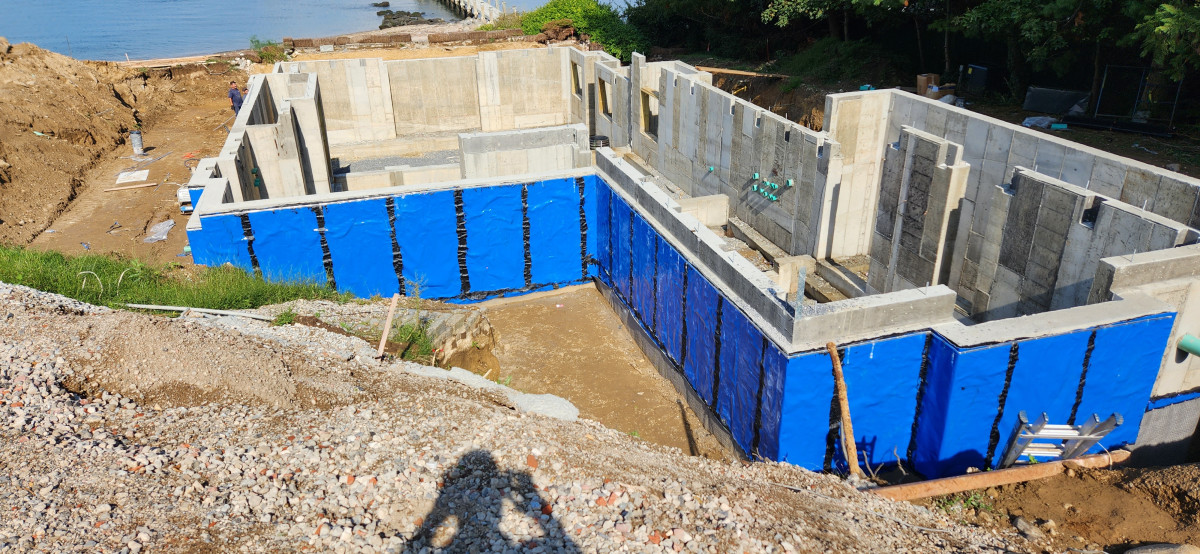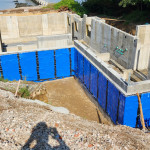Are you facing persistent leaks and moisture issues on your roof? Integrated waterproofing systems use bitumen and rebar to offer a reliable fix against water damage. This post presents key principles of these systems, discusses their benefits compared to traditional methods, and provides practical tips for proper implementation. You will gain straightforward advice to reduce repair expenses and secure lasting protection for your property.
Understand the Key Principles of Integrated Waterproofing Systems
This section outlines the role of integrated waterproofing. It covers the definition and importance of these systems in protecting critical infrastructure, the different types available, how technology improves waterproofing, and the science behind materials interacting with soil and groundwater. Readers can also find an email address for additional details and practical advice.
Definition and Importance of Integrated Waterproofing Systems
Integrated waterproofing systems refer to a method where an epoxy-based coating merges with construction materials to offer strong protection against water penetration. This approach supports compressive strength and maintains a resilient structure, ensuring that moisture does not compromise a building’s integrity.
The significance of these systems appears in projects where water exposure poses a threat to construction durability. By applying a specialized epoxy coating, professionals secure structural stability and improve compressive strength, thereby reducing maintenance needs and extending the lifespan of key building elements.
Types of Integrated Waterproofing Systems Available
Engineered waterproofing systems integrate epoxy powder coatings to address moisture challenges in various structures. They often combine grout sealants with materials designed for precast concrete, effectively limiting capillary movement that can affect tunnel settings.
Industry professionals select systems based on specific site demands, employing formulations that merge refined powder compounds with grout applications in concrete installations. These solutions work well to restrict water migration through porous layers, offering practical protection against capillary action and moisture infiltration in tunnel areas.
Role of Technology in Integrated Waterproofing Solutions
Modern technology boosts integrated waterproofing by using precise spray applications and pump-controlled methods to apply a uniform membrane that channels water to proper drainage paths. Such techniques lower infiltration risks and protect structures from unwanted moisture penetration.
Engineers employ automated controls to monitor the distribution of waterproof coatings, ensuring the membrane adheres evenly across surfaces. This precise procedure uses both pump and spray technology to optimize drainage flows and reduce potential infiltration challenges in demanding environments.
The Science Behind Waterproofing Materials
Scientific research shows that a liquid formulation integrated with cement forms a durable barrier that effectively combats corrosion on structural surfaces. Independent testing confirms that these compounds safeguard a building’s foundation and support extended warranty standards.
Controlled laboratory trials verify that modified waterproofing materials bond well with cement, significantly reducing corrosion risks in exposed areas. Field evaluations reveal that such systems consistently secure structural foundations while upholding rigorous warranty conditions.
Explore the Comprehensive Advantages of Integrated Waterproofing Systems
Integrated waterproofing methods provide notable durability with combined interior and exterior strategies, lower project expenses, and improved building longevity with robust structural strength. Environmental benefits and sustainability are examined through practical insights. Industry data shows crystal clarity in plaster applications strengthens substrate performance while supporting LEED guidelines.
Enhanced Durability Through Integrated Solutions
Integrated waterproofing systems boost durability by combining portland cement with a specialized sealant applied to wall surfaces and reinforced steel frameworks. Experts review each safety data sheet thoroughly to verify material compatibility and secure a stable barrier against water intrusion.
Industry professionals report that these integrated solutions effectively extend the service life of structures by limiting moisture penetration and deterioration. Field evaluations confirm that applying sealant with portland cement on walls and steel components, as guided by safety data sheets, reduces repair needs and maintains structural integrity.
Cost-Effectiveness of Combining Interior and Exterior Approaches
Combining interior and exterior treatments reduces overall expenses by streamlining both material and labor requirements. Applying a silicon-infused barrier on exterior surfaces along with targeted basement protection creates a design that functions like a dam, effectively keeping water intrusion at bay.
Industry experts note that this integrated approach cuts down on frequent maintenance calls and repair needs. The dual-layer method uses silicon-based compounds and precise design strategies to secure spaces against water exposure, ultimately supporting long-term cost savings.
Improved Building Longevity and Structural Integrity
Industry experts note that integrated waterproofing systems employing shotcrete control permeability in critical structural regions and support overall durability. They combine basement waterproofing practices with timely concrete repair to form a resilient framework that endures moisture exposure over extended periods.
Contractors apply these techniques in projects such as swimming pool installations to manage water flow and safeguard structural elements. They use targeted measures that reduce the impact of moisture, thereby lessening the need for frequent concrete repair and improving long-term building performance.
Environmental Benefits and Sustainability Considerations
Integrated waterproofing systems support environmental efforts by reducing resource waste and lowering maintenance demands. The use of advanced technology promotes strong adhesion between waterproof coatings and the building envelope, ensuring durable water resistance. This method proves effective in projects such as bridge construction, where sustainability and extended lifespan are key priorities.
Industry experts report that robust adhesion from these systems strengthens structural performance while meeting sustainability targets. Controlled application of technology secures the building envelope and minimizes repair intervals, preserving energy and resources. Field evaluations on bridges confirm that this approach delivers both eco-friendly and cost-effective results.
Analyze How Integrated Waterproofing Systems Maximize Protection
Preventing water infiltration defends infrastructure against damage while reducing mold and mildew risks. The systems counter severe weather pressure and support improved air quality. Technical pdf data confirm that these solutions deliver reliable carbon management, providing lasting protection in high-impact plant conditions. Experts address each aspect in the following sections.
Prevention of Water Infiltration and Damage
Integrated waterproofing systems shield concrete from moisture intrusion by forming a continuous barrier that minimizes water damage over time. Engineers in the united kingdom apply these methods on a range of projects to secure structural strength and reduce repair needs in areas prone to excessive moisture.
Field evaluations confirm that targeted waterproofing treatments effectively stop water penetration in concrete, thereby reducing water damage risks. Industry experts in the united kingdom report that consistent application of these systems safeguards vital infrastructures and improves overall durability under demanding conditions.
Mitigation of Mold and Mildew Growth
Integrated waterproofing systems form a durable barrier that minimizes excessive moisture in building materials. This process limits the damp conditions where mold and mildew thrive, ensuring that surfaces remain comparatively dry in high-humidity areas.
Independent assessments indicate that applying these systems translates to fewer occurrences of mold and mildew growth in at-risk zones. Industry professionals note that precise application in vulnerable environments leads to a cleaner interior and reduces repair needs over time.
Shielding Against Severe Weather Conditions
Integrated waterproofing systems form a continuous barrier that resists heavy rains, strong winds, and rapid temperature shifts. Industry experts report that structures treated with these coatings show reduced moisture penetration and improved resistance in the face of severe weather conditions.
Independent evaluations confirm that modern waterproofing applications withstand harsh weather cycles while preserving structural durability. Field observations indicate that these systems maintain their protective performance during storm events and extended periods of environmental stress.
Enhanced Air Quality and Health Benefits
Integrated waterproofing systems form a continuous barrier that blocks water intrusion, reducing moisture that often leads to mold and airborne contaminants. Industry research confirms that properly applied systems keep indoor air cleaner and help lower the risk of respiratory issues among building occupants.
Field evaluations demonstrate that precise waterproofing limits the formation of damp zones that encourage allergen buildup. Experts report that controlled moisture levels contribute to maintaining a stable indoor climate, ultimately supporting better living conditions and healthier spaces.
Identify Best Practices for Implementing Integrated Waterproofing Systems
Integrated waterproofing success rests on careful site assessment, precise selection of materials and methods, reliable professional installation and maintenance, and review of case studies showing proven results. Each step ensures structures remain durable and secure, reducing long-term costs and supporting high performance.
Assessing Site Conditions and Needs
Industry professionals perform a detailed evaluation of site conditions before installing integrated waterproofing systems. They assess factors such as soil drainage, groundwater exposure, and material compatibility to develop a plan that meets local challenges and protects structural elements. This methodical assessment minimizes potential complications during installation and promotes a tailored approach to moisture control.
Experts examine historical moisture data and physically inspect existing structures to determine vulnerabilities in the environment. They use collected insights to choose materials and adjust application techniques, ensuring each project receives appropriate protection against water infiltration. This careful process helps maintain long-term durability and cost efficiency in construction projects.
Selecting Appropriate Materials and Methods
Industry experts identify suitable waterproofing materials by assessing chemical compatibility, adhesion properties, and moisture resistance to address diverse construction challenges. They compare performance data and field outcomes to choose compounds that reliably support long-term structural stability.
Method selection plays a critical role in achieving uniform protection and extending building longevity. Professionals favor application techniques that deliver precise layering and controlled coverage, ensuring that the integrated waterproofing system effectively blocks moisture ingress and maintains durability in varying environments.
Importance of Professional Installation and Maintenance
Professional installation by experienced technicians plays a key role in ensuring that integrated waterproofing systems provide maximum durability and protection. Experts follow strict guidelines to apply coatings and compounds accurately, resulting in reliable barriers that resist water intrusion and support structural strength.
Ongoing maintenance performed by skilled professionals preserves the protective qualities of these systems over time. Regular inspections and prompt repairs help prevent potential issues, allowing the system to perform consistently and safeguarding the long-term integrity of the structure.
Case Studies of Successful Implementations
Case studies document that integrated waterproofing systems provide effective moisture barriers in various building projects, resulting in a reduction of water-related deterioration. In one project, a construction firm used an epoxy-based coating on critical structures and observed a significant decrease in repair frequency over several years.
An infrastructure project involving a transportation tunnel further verified the benefits of well-planned waterproofing installation. Field evaluations confirm that targeted material selection and careful application contribute to extended durability and sustained structural protection in moisture-prone environments.
Conclusion
Integrated waterproofing systems provide robust protection by merging advanced epoxy coatings with construction materials, forming a continuous barrier against water intrusion. They defend critical structural elements, lowering repair frequency while extending the lifespan of key components. Cost-saving benefits emerge as these methods reduce maintenance efforts and optimize installation processes. Experts recommend thorough site evaluations and careful material selection to secure enduring performance and structural integrity over time.





